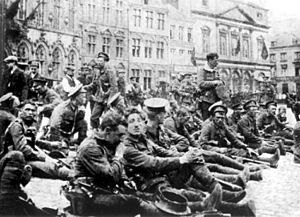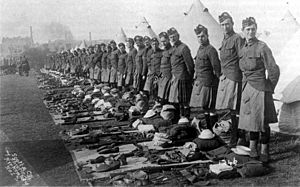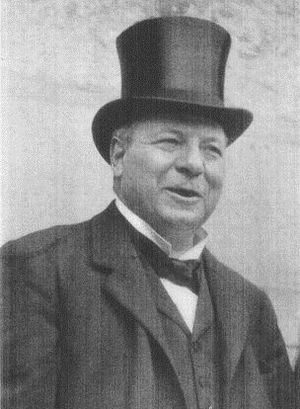Haldane Reforms facts for kids
The Haldane Reforms were big changes made to the British Army between 1906 and 1912. They are named after Richard Haldane, who was in charge of the army at the time. These changes were very important. They helped the army get ready for modern wars. The reforms happened after the Second Boer War. Britain learned many lessons from that war.
A key part of the reforms was creating a special "expeditionary force." This force was trained and ready to fight in big wars overseas. Before, the army wasn't well-prepared for fighting far from home. The new force had a clear plan and all the support it needed.
At the same time, the army's reserve forces were made stronger and bigger. This meant more soldiers could join the overseas forces when needed. They also helped protect Britain at home. The old Volunteer Force and Yeomanry became the new Territorial Force. The Militia became the Special Reserve. These changes were part of the Territorial and Reserve Forces Act 1907.
To help young people learn military skills, the Officer Training Corps was started. This was for students in public schools and universities. All these steps aimed to connect the army and the public more closely. Haldane wanted a "nation in arms," meaning everyone played a part in defence.
A new Imperial General Staff was also created. This group helped all parts of the British Empire's military work together. This included forces from the Dominions (like Canada and Australia) and British India. They made sure everyone followed the same plans and goals. Finally, the regular army got new training ideas. These were written down in Douglas Haig's new Field Service Pocket Book.
When the First World War started in August 1914, these changes were put to the test. The new Expeditionary Force quickly went to Europe. The Territorial Force and Reserves were called up, just as Haldane had planned. They formed a vital second line of defence.
Contents
Why Were These Reforms Needed?
In the mid-1800s, the British Army fought in two major wars: the Crimean War and the Indian Mutiny. These wars showed that the army wasn't ready for large, modern battles. So, the government started making changes.
The first set of changes happened from 1858 to 1860. The Staff College was created to train officers to be professional soldiers. The old East India Company army became the British Indian Army. This helped control forces in India better. Also, the Volunteer Force was formed to defend Britain while the regular army was overseas.
More changes came between 1868 and 1872. These were called the "Cardwell Reforms," named after Edward Cardwell. He was the Secretary of State for War then. Officers could no longer buy their ranks. New soldiers joined for shorter times in specific regiments. These changes made the army's soldiers better trained. They also created a skilled group of reserve soldiers. These reserves could be called back to duty in an emergency.
The army's regiments were also reorganized. Local regiments were linked to specific areas for easier recruitment and training. Volunteer regiments also became part of this system.
The "Childers Reforms" in the early 1880s continued these changes. They combined linked regiments into single, larger units. Local militia and volunteer groups also joined these regiments.
These reforms created a large, well-trained force in Britain. This force could be sent overseas during a crisis. It had reserves and home-service volunteers to support it.
Lessons from the Second Boer War
When the South African War (also known as the Second Boer War) began in 1899, Britain quickly sent many troops. About half a million soldiers went, including volunteers from Canada, Australia, and New Zealand.
However, the army system soon faced problems. Within a year, the Regular Reserve and Militia Reserve were completely used up. This meant there were no more trained soldiers to call upon. The army had to try new ways to get more fighters. The Militia provided soldiers for garrisons. Volunteers sent companies to join regular battalions. The Imperial Yeomanry was created to provide much-needed mounted soldiers. Many auxiliary forces also came from the Dominions.
After the war, some attempts were made to reform the army, but they didn't do much. Two important groups, the Esher Committee and the Norfolk Commission, studied the army in 1902. They reported their findings in 1904.
The Esher Report suggested big changes to how the army and War Office were managed. The Norfolk Commission looked at the auxiliary forces. They said these forces were "unfit for service." They suggested practical changes. They also made a big suggestion: universal military service, meaning everyone would have to serve in the military. Some of these ideas were started in 1904-1905. But many people opposed the main plans.
Key Changes Made by Haldane
In December 1905, a new government came to power. Richard Haldane became the Secretary of State for War. This was almost by accident, as he wanted a different job. But he became very successful in this role. Douglas Haig later called him "the greatest Secretary of State for War England has ever had."
Haldane knew that the army generals were tired of constant changes. So, he worked to gain their trust and support. He removed officers who didn't support his plans. With help from Lord Esher, Major-General Haig, and Colonel Ellison, he designed and put in place reforms. These reforms helped prepare the British Army for the start of the First World War.
Creating the Expeditionary Force

After a big election win in 1906, Haldane focused on a crisis between France and Germany. Britain's Foreign Secretary, Sir Edward Grey, had secretly agreed to help France if it was attacked. Haldane then thought about how Britain could do this.
He quickly realized the army needed a regular "expeditionary force." This force would be specially trained to fight in Europe. The question was how to create it. Haldane decided on a force of six infantry divisions with all their support units. They would be organized in peacetime and ready to move quickly to Europe.
Since the army now had a clear purpose, it could be reorganized to fit this role. Any parts that didn't fit could be removed to save money. This meant getting rid of ten infantry battalions and some artillery units. Some overseas garrisons were also pulled back. The army in Britain was reorganized into six divisions by January 1907. It also had a large Cavalry Division and two mounted brigades for scouting. In February 1907, Haldane announced that despite creating this new force, overall spending was reduced by millions of pounds.
Forming the Territorial Force

Once the regular army was set up as an Expeditionary Force, lessons from the Second Boer War showed it needed a larger "second line" of support. Haldane worked hard to get Lord Esher's support. Esher's group had suggested forcing people to join the army (conscription). But Haldane still faced a strong campaign for conscription. This campaign was led by Field Marshal Lord Roberts and supported by retired generals and some politicians.
Haldane first planned the Territorial Force for both home defence and as a second line for the expeditionary force. He said that after six months of training, these soldiers would be ready to go abroad if they wished. He called the Territorial Force "the sole means of support and expansion of the professional army."
However, Haldane faced opposition. Lord Roberts and others wanted conscription. Some members of Haldane's own party worried about building a large expeditionary force. Labour members were concerned about militarism. Also, existing volunteer groups didn't like losing their independence. The Militia even strongly opposed the plans.
To deal with this opposition, Haldane changed the official purpose of the Territorial Force. When he presented the Territorial and Reserve Forces Bill to Parliament in March 1907, he said it was only for compulsory home defence. He softened his original idea, saying that Territorials "could go abroad if they wish."
Under this plan, the Volunteers and Yeomanry became the Territorial Force. Local groups called County Territorial Associations managed them. The Militia was disbanded. Its training centres were used for a new, all-infantry Special Reserve. These reservists had not served in the regular army but agreed to fight with regular forces in wartime.
The Territorial and Reserve Forces Act 1907 passed Parliament easily. The new Territorial Force would have fourteen infantry divisions, fourteen cavalry brigades, and many support units. Local groups would raise, organize, and pay for them. But they would serve under the War Office during wartime. The design of the Territorial Force was much more than just for home defence. It had full divisions with artillery, engineers, and medical services.
New Training and Strategy
In November 1906, Douglas Haig was put in charge of staff duties at the War Office. His job was to create new training plans for the army. The Esher Report had suggested new training manuals, but they hadn't been fully used. In 1907, a new "Field Service Pocket Book" was created. It was updated in 1908 and became "Field Service Regulations, Part I – Operations" in 1909. This book became the main training guide for all parts of the army. It brought together the best tactical and strategic ideas learned from the South African War.
Another part, "Administration," was more difficult. Haig wanted a completely new system. This manual would cover the entire organization of an army in the field. This included base camps and supply lines, not just fighting units. But other high-ranking officers disagreed. They felt it was unnecessary and that Haig was stepping into their area. However, with Haldane's support, Haig pushed it through, and it was adopted.
Officer Training Corps
One potential problem was finding enough skilled officers for the army in wartime. There was also an immediate need for trained officers for the Territorial Force in peacetime. A committee was set up in 1906 to study this. It made two reports. One focused on university and school groups. The other was about the Special Reserve.
The main suggestion for schools and universities was to reorganize existing Cadet Corps and Rifle Corps. These groups had been formed informally. The idea was to make them a standard force, managed and supported by the War Office.
In 1908, the "Senior Division" was set up in universities. The "Junior Division" was created in public schools. New rules stated that the goal was to provide "elementary military training" to prepare students to become officers.
This program was popular. By the end of 1910, there were 19 university groups and 152 school groups. By early 1912, these numbers had grown even more. A total of 23,700 cadets were enrolled. Over 800 former cadets had already become officers in the auxiliary forces.
Imperial General Staff
In the late 1800s, the British Empire's defence policy changed. Instead of just one central army and navy, the self-governing Dominions (like Canada, Australia, New Zealand, and South Africa) started to create their own forces. They also began to take responsibility for defence in their own regions. In all four Dominions, these forces had a small core of professional soldiers. The rest were much larger volunteer forces. This continued until the Second World War. The South African War showed how important these Dominion forces were.
Even though forces were developing locally, the goals for defending the entire Empire remained the same. In 1907, a suggestion was made to Dominion leaders. It recommended that all Imperial forces be organized in a standard way. This would be similar to how the British Army and the Army in India (British and Indian army units combined) were recently reorganized.
The leaders liked this idea. They went even further and suggested creating a general staff from forces across the entire Empire. This Imperial General Staff would connect all the national forces. It would also oversee the development of a single, uniform defence plan. This would help make the forces more consistent. However, it was made clear that the Imperial General Staff could only offer "guidance" to local governments. It would not have binding power over the national forces.
This new system was approved at an Imperial conference in July 1909. The conference supported the new structure and the idea of standardization. It also stressed that it would not limit "the autonomy of the self-governing Dominions."
How Did They Help in World War I?
When the First World War began in August 1914, Haldane's changes faced their biggest test. The Expeditionary Force of six divisions quickly went to Europe. They faced huge numbers of enemy soldiers but held the left side of the French Army's line. Out of the 90,000 soldiers in the original British Expeditionary Force (BEF) in August, four out of five were dead or wounded by Christmas.
Meanwhile, the Territorial Force of 14 divisions and the Reserves were called up. This was just as Haldane had planned for a second line of defence. The call-up happened on time, and the divisions were armed. By April 1915, six complete Territorial divisions had been sent to France.
Sir John French, who was the commander of the BEF at the time, said: "Without the assistance which the Territorials afforded between October 1914 and June 1915, it would have been impossible to hold the line in France and Belgium."
Douglas Haig, who later took over from French, called Haldane "The greatest Secretary of State for War England has ever had." Haldane's amazing work built upon the strong foundations laid by Viscount Cardwell and his main military advisor, Garnet Wolseley.


